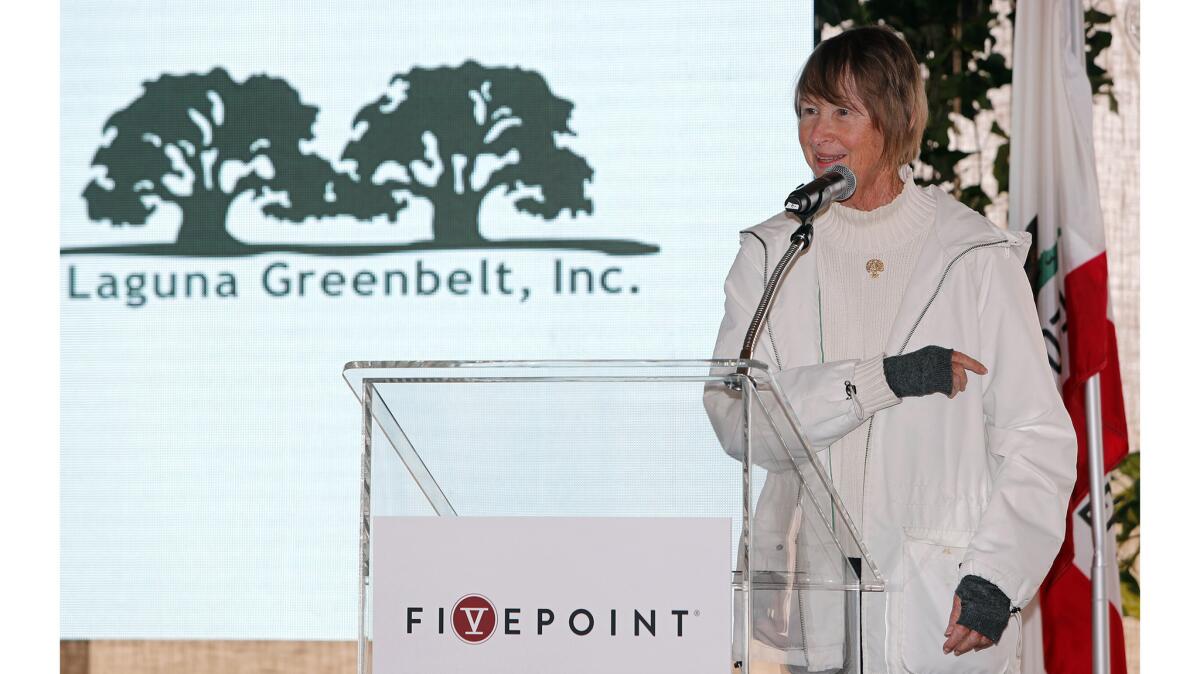Wildlife corridor linking O.C.’s coast and Santa Ana mountains gets started at ground-breaking ceremony
- Share via
Ground was officially broken this week on a $13-million effort to restore a wildlife corridor that will connect the Cleveland National Forest with Orange County wild coastal terrains.
The project, in the making for more than two decades, seeks to encourage biological diversity in the animals that dwell in the more than 20,000 acres of coastal chaparral surrounding Laguna Beach.
“Today we are returning the land that we have been borrowing,” Irvine Mayor Donald Wagner said Tuesday during a ground-breaking ceremony. “It’s going to be home for so many of the animals that were here long before us.”
The project entails restoring 2.5 miles of a 6-mile corridor to allow species such as the gray fox, bobcat, coyote and various native birds to travel between Orange County coastal habitat and the Santa Ana Mountains.
The 2.5-mile piece, at its widest nearly one-quarter mile, is currently dirt awaiting replenishment spanning the eastern border of the Orange County Great Park in Irvine. The grounds were formerly used for agriculture and as the Marine Corps Air Station El Toro golf course.
The corridor is being funded by the Great Park developer, FivePoint Holdings, which is developing 688 acres of the park for the city for the ability to build thousands of homes nearby.
Restoration started earlier this year when FivePoint began grading. Contractors will be selected in spring to replant vegetation.
The project is estimated to be complete by mid-2019.
Elisabeth Brown, president of grassroots environmental group Laguna Greenbelt, said by phone that she’s been fighting for the corridor since the early 1990s.
Laguna Greenbelt has contributed to a number of environmental triumphs in the county, including establishing the 22,000-acre greenbelt around Laguna Beach, Crystal Cove State Park and the 38,000-acre Nature Reserve of Orange County.
Brown, along with others, discovered at that time that Laguna’s coastal habitats were like an island, segregated from other natural terrains.
Being divorced from larger natural habitats has had a deleterious effect on the animals living in that cramped space.
“The land is not big enough,” Brown said of the coastal habitat. “An animal looking for a mate can’t find one that they aren’t related to. You end up with non-diverse animals and dangerous situations.”
Diversity is crucial in an animal population because it safeguards against singular catastrophic events. If animals are mating with their family members and reintroducing the same traits into the collective genome, a single disease could wash through the population and wreak havoc.
“You have to have diversity and the only way to do that is for the animals to move freely between one large chunk of open space to another,” Brown said.
More open space means more potential mates.

Brown said the Laguna Beach fire of 1993 also presented another necessity for a wildlife corridor.
Animals had difficulty retreating from the rapidly expanding fire due to lack of open space. Many moved to the coastal canyons but were unable to get to the mountains, she said.
After the blaze, animals from surrounding habitat could not travel to the coastal areas to replenish the populations.
Brown said the possibility of restoring a wildlife corridor arose in 1993 with word of the eventual closure of the El Toro Marine base, which shut down in 1999.
However, the Marines’ departure spawned a proposal for an airport on the land. That effort passed in 1994, despite significant opposition from nearby residents.
A battle ensued for several years with anti-airport Irvine residents coming up with the Millennium Plan in 1998, which proposed a combination of high-density residential, office and commercial space along with a museum and park.
Brown said she was able to persuade both sides to incorporate the wildlife corridor into their plans.
Irvine then unveiled plans for the Great Park in 2001, replacing the airport measure. Voters approved the park in 2002.
Miami-based home construction company Lennar Corp. purchased the land in 2005, striking a deal with Irvine to build the park.
The corridor project lay in hibernation for many years, Brown said. Then in 2012, Fivepoint Holdings, which broke from Lennar in 2009, reached out to Brown.
The company facilitated a weekend-long meeting with Laguna Greenbelt and various wildlife experts of their choosing.
Because Irvine supported a corridor, whichever company developed the Great Park was bound to restore a corridor, Brown said. Yet there weren’t specifics about the project, so the meeting finally delineated the details.
Brown said this corridor plan was adopted by the city of Irvine in 2013.

Emile Haddad, chairman and CEO of FivePoint, said in a phone interview that the project is atypical for the company because restoring a wildlife corridor is unique. In general, Haddad said, the company balances its urban developments with greenery and heeds environmental concerns.
“It’s a critical thing to look at as you are urbanizing to not disrupt the natural migration of animals,” Haddad said.
FivePoint is working on a variety of projects in the Great Park, including a 194-acre sports complex that’s twice the size of Disneyland.
While there is a rough timeline for restoring the corridor, Haddad said the project’s unprecedented nature needs greater flexibility.
“This is not your typical construction project where you can put together a timeline and say we are going to pour concrete now,” Haddad said. “When you are restoring a place with vegetation, you are really at the mercy of Mother Nature.”
Brown said there are a number of challenges ahead, including finding ways for wildlife to navigate obstacles like roads and railroad tracks.
“Nobody has tried to put a corridor in at this length across an urban landscape before,” Brown said. “This is somewhat experimental.”
Twitter:@benbrazilpilot
All the latest on Orange County from Orange County.
Get our free TimesOC newsletter.
You may occasionally receive promotional content from the Daily Pilot.






